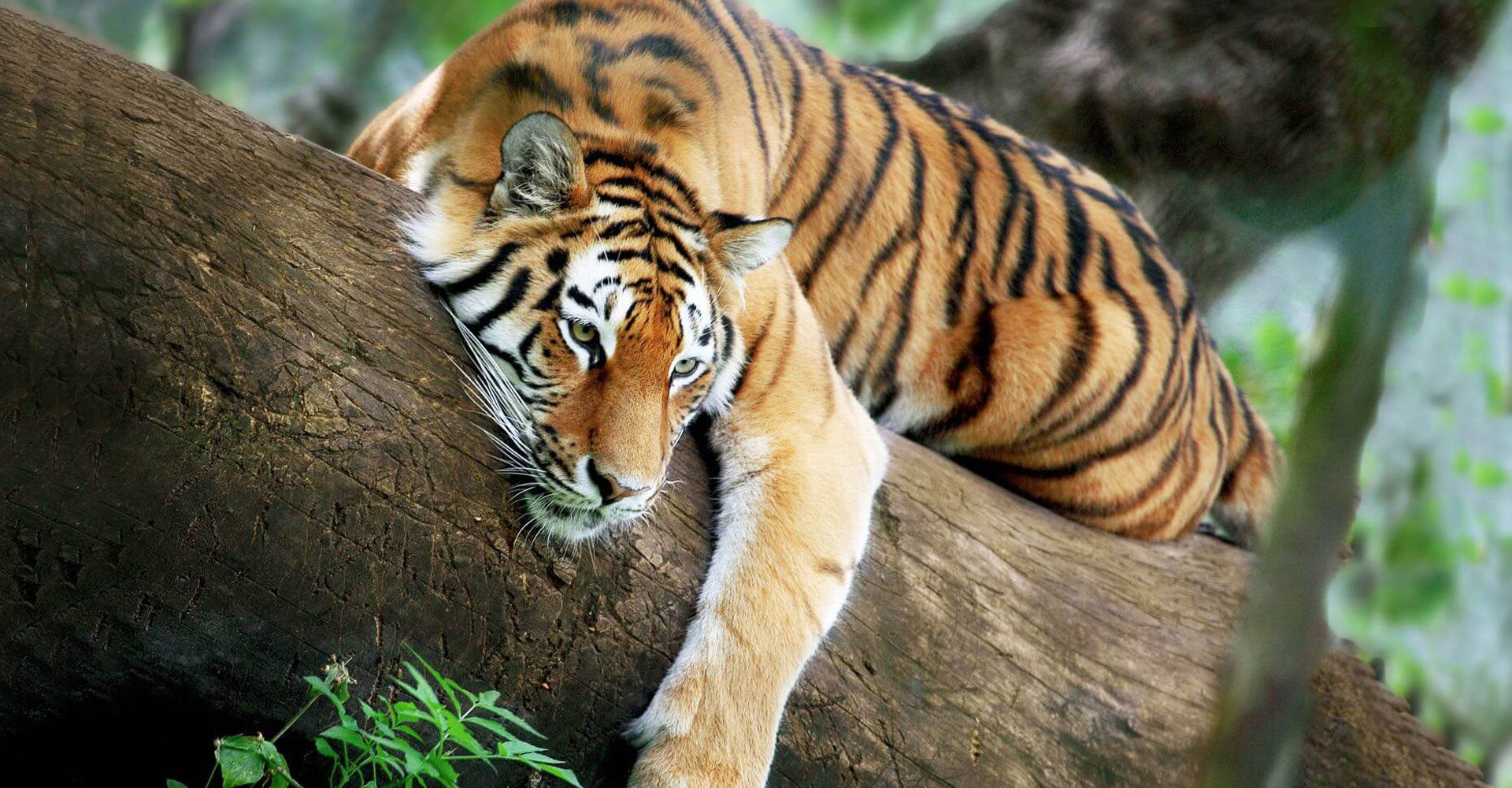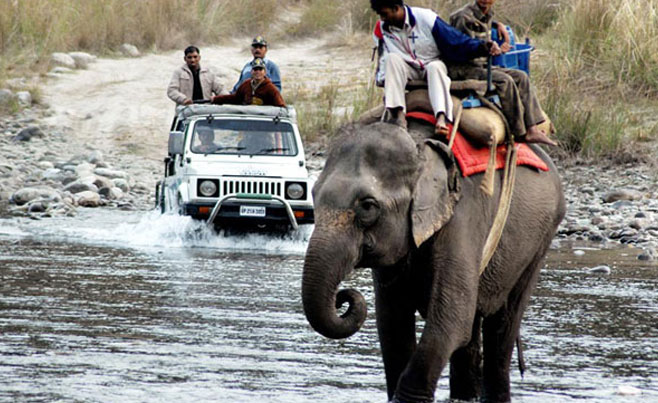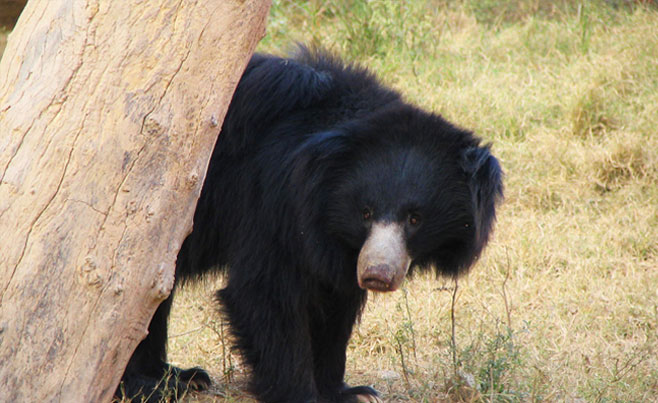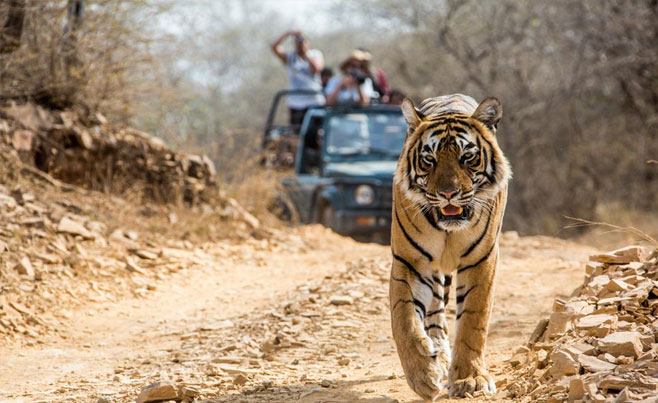Jim Corbett National Park
Best Time To Visit
Jan
Feb
Mar
Apr
May
Jun
Jul
Aug
Sep
Oct
Nov
Dec
Most Popular
High Sighting
Park Closed
Low Sighting
About Jim Corbett National Park
Species
Tiger, Chital, Langur, Gharial, Sloth bear, Elephant, Peacock
Overview
Aptly called the 'Land of Roar and Trumpet', this forest of flowing rivers, blue waters and sal-dappled glades, was christened after the famous Colonel 'Gentleman' Jim Corbett. There is something absolutely magical about being in tiger and elephant country, where unexpected sights and sounds present themselves at almost every turn. Many of Jim Corbett's enthralling tales, including the Man-eaters of Kumaon and the Maneating Leopard of Rudraprayag originated here in these famous Kumaon hills, where the shikari used to hunt wild animals, until F.W. Champion, who pioneered wildlife photography in India, taught him to appreciate living tigers. Eventually Gentleman Jim put his guns down in favour of the camera; and that is the example that all humans who venture into this magnificent Park must now emulate. India's first National Park, Corbett is ranked as one of the best-managed parks in the subcontinent. It also happens to be one of the last surviving stretches of untouched sub-Himalayan wildernesses. The park lies in the undulating Shiwalik ranges, distinct from the Himalaya in that they were formed from the products of massive erosion – sand, gravel and stones – of the Himalaya. In this part of the Kumaon hills, they melt into the Himalayan chain. Patlidun is an elevated, flat valley through which the picturesque Ramganga River, the only perennial source of water in the park, flows. Thus cradled in the foothills of the Himalaya, in the Pauri Garwal hills and Nainital, the forest spreads over an area of 520 sq. km., of which a core area of 320 sq. km. is inviolate. The South Patlidun area ranges in elevation from 400m. to 1,210m. (the Kandla peak) and comprises a huge east-west valley through which three densely forested, parallel ridge systems run. Offshoot ridges go from north to south forming smaller valleys and these provide valuable and very secluded niches for wild animals to hunt and breed. The topography is varied with hilly areas, riverine habitat, marshes, deep ravines and flat plateaux. The Ramganga river enters from the northeast and flows through most of the park till it forms the Kalagarh reservoir created by a multipurpose hydroelectric dam, the largest earthen dam in Asia. Corbett is the ultimate tiger haven, but because of its thick undergrowth and tall grass it is actually quite difficult to spot tigers. A plentiful prey base does, however, support a tiger population, variously estimated to range between 90 to 120. Visitors often report seeing the tiger on the main tar road between the Dhangari entrance gate and Dhikala. If you do not see one, pugmarks are a sure sign that they are around. Apart from the tiger, you could see as many as 50 different species of mammals. Leopards are often seen in the hilly areas and outskirts of the park, because the larger and more powerful tiger dominates the prime areas. The jungle cat and the rare fishing cat frequent grassland and riverine areas. Elephants are the dominant mammals of Corbett, but even these are dwarfed by the larger-than-life vistas. They can be seen bathing, drinking and feeding in the Ramganga River and its food-rich surrounds. Herds are seen as frequently as lone tuskers. You could chance upon them in thick vegetation or watch them from a distance from machans built over salt licks and water holes throughout the park. Elephants once used to migrate out of the park, but the Ramganga reservoir has cut off one migratory route and some herds are now confined. Relatively easily visible are chital, sambar (the largest deer in Asia) and barking deer. Wildboar may suddenly cross the jungle road as you travel. Huge males wander in sounders with females accompanied by striped and marked piglets. If startled by your presence, the group often takes a moment or two from their foraging to regroup and make their getaway into the undergrowth almost in single file. Large male boars can be dangerous if cornered and have been known to fatally wound tigers in battle. Bharal, goral, Himalayan tahr and serow can be seen. In the Bijrani area chances of seeing sloth bear are excellent. Attracted by both termites and the sweet nectar of mahua flowers, the bears often seem inebriated. Jackals come close to the Dhikala campus, where they seem to thrive on small rodents and mammals such as blacknaped hare that live in the grassy chaurs. The call of the langur is one of Corbett's most distinctive sounds. Spread throughout the park, these monkeys can often be seen teamed up with barking deer and chital that have learned to feed on the fruit and leaves dropped by monkeys. The gharial and the mugger or marsh crocodile are both found in the Ramganga river. Tortoises and fresh water turtles are effective scavengers and can also be seen. Corbett is a very important breeding ground for Indian reptiles. The Indian python, viper, king cobra and krait – all poisonous –inhabit the park. Monitors and other lizards are amongst the 25 reptile species documented in the park. The tiger, wild dog, hog deer and Indian pangolin are rarely seen outside the National Park although they once roamed the entire terai region. The Himalayan black bear may sometimes be seen during bitter winters at Kandla, but they rarely descend to the lower slopes or valleys. Large packs of dhole or wild dog may be seen in the Bijrani area.
Trails and Excursions
Early morning elephant rides from Dhikala into the chaurs must not be missed. Jeep rides before dawn and in the late afternoons till dusk are rewarding. One of the best ways to watch wildlife without disturbing them is to take up post on one of the watchtowers. Perhaps the easiest of the lookout towers to spend time at is the one situated just one km. from Dhikala. Armed with a pair of binoculars, a comfortable cushion and sleeping bag, some food and water and plenty of silence, you could just come away with the experience of a lifetime. The chaur at Dhikala is picturesque and abuzz with wildlife. En route from the Dhangarhi gate to Dhikala, to the right of the road, is 'Highpoint', from where you may see resting muggers and gharial crocodiles in the river. Visit Kanda the highest point for a spectacular view. The old forest rest house in Kanda used to have a visitor's book in which Jim Corbett's entries were recorded at Kanda and Mohan. Kalagarh Reservoir attracts waterbirds, mugger and gharial. The mahseer and malee fish breed here in Corbett. 32 km. from Ramnagar on the Nainital road, past Kaladhungi, is Jim Corbett's old house which has been turned into a museum. There is an Orientation Centre at Bijrani and a restaurant that is worth a visit. At Dhikala, wildlife films are shown free every evening in the open area overlooking behind the canteen. The restaurant there serves up a delicious breakfast. Try it after a morning round in the chaur.
How To Reach
By Air:
Phoolbagh/Pantnagar (51.2 km.).
By Rail:
Ramnagar (19 km.) There is a direct train from Delhi to Ramnagar (250 km.) Moradabad, on the way, offers a convenient connecting point to and from other cities on express trains.
By Road:
From Delhi, a motorable road links Corbett. The drive could take 6-8 hours depending on traffic in and out of Delhi and Moradabad. From major cities in the north, the park is easily accessible by road making it a favourite wildlife destination.
Tips:
Trekking and walking in the wild is strictly not permitted. The park has several entrance gates. The closest leads to the camp at Bijrani and is one km. away from Ramnagar. Dhangari Gate is 18 km. towards Ranikhet and accesses the northern and northwestern side of the park, along the Ramganga valley and the camp at Dhikala. Give yourself enough time to visit all the different areas of the park. For birdwatchers, a book on the birds of Corbett would be good accompaniment. Hire a four-wheel drive vehicle. Gates close at sunset. Night driving is strictly not allowed. Travellers Cheques can be exchanged at the State Bank of India in Ramnagar. If you plan to drive in winter, check out the smog situation. It can reduce visibility on the roads to just a few metres till noon




